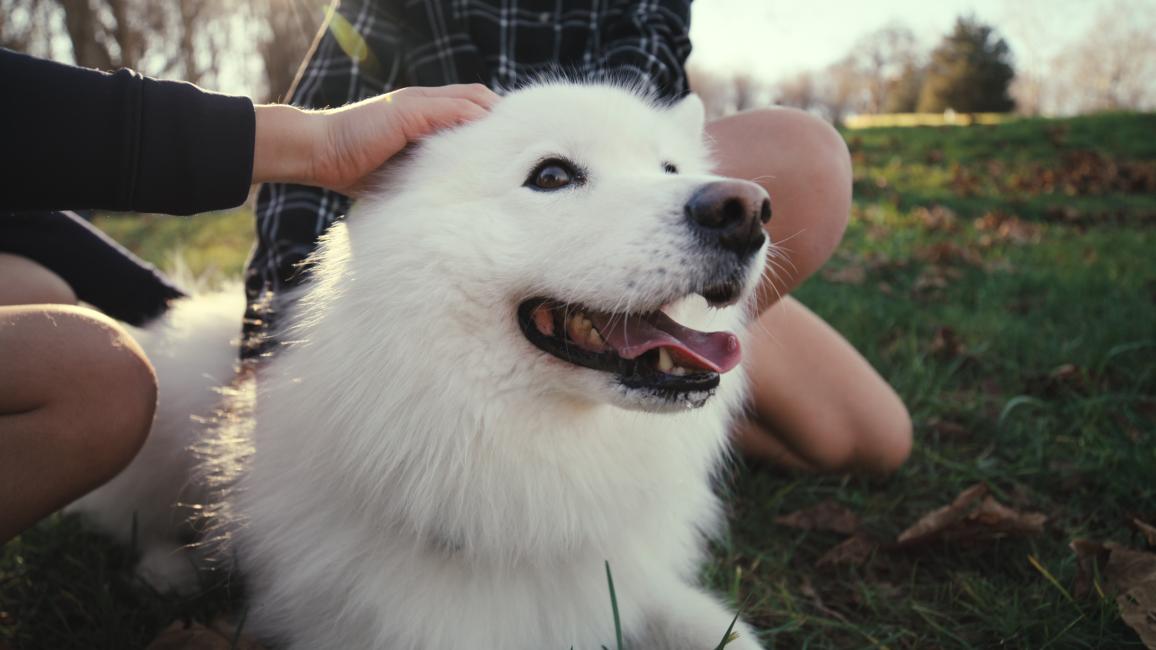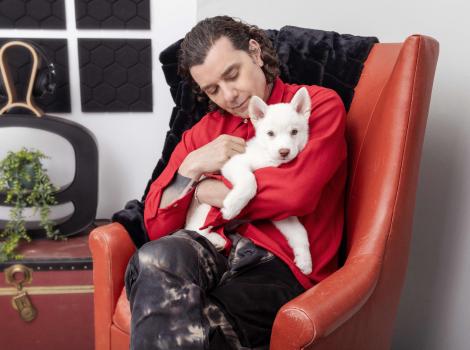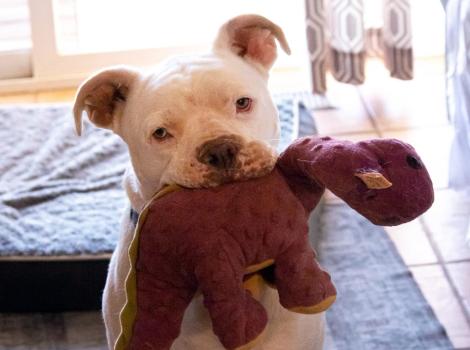Why people love dogs — and they love us right back

“Don't judge a dog by its cover.”
Brian Hare — Duke University professor and founder of the Duke Canine Cognition Center — would know. He’s been delving into the minds of dogs for years.
“The question is, ‘Who is your dog and what makes them so wonderful?’” he says. “Because each of them is an individual, and it's those little personalities that we fall so deeply in love with.”
Brian and his team’s work is featured in the new Netflix documentary produced by Red Rock Films, Inside the Mind of a Dog, which digs into the history, science, and pure love behind the human-canine bond. In the documentary, you’ll meet some of the wet-nosed, squishy-bodied “students” of Duke’s Puppy Kindergarten, where researchers are learning more about how puppies understand the world and their human friends.
Puppy Kindergarten: The New Science of Raising a Great Dog is Brian’s new book on the topic with co-author Vanessa Woods, fellow scientist and Puppy Kindergarten director. It’s an honest, humorous, and heartfelt window into the richness and diversity of puppy minds — and how they’re seemingly wired to be our furry sidekicks. But to really understand that bond, we must travel back in time to when our people and pup ancestors first met.

Becoming ‘human’s best friend’
Dogs (Canis familiaris) and wolves (Canis lupus) share a whopping 99% of their DNA, but there’s good reason why we’re not sharing our beds with wolves. Evidence suggests that dogs’ evolution from wolves began roughly 12,000 to 40,000 years ago — and it all came down to friendliness.
“I think a population of wolves chose us, but then we were very tolerant of it and excited by it,” Brian says. “And it ended up being a very mutualistic relationship. … Everybody alive when dogs began to be domesticated was living as hunter-gatherers or foragers, and why would those people be excited about dogs being near and around them? Well, the No. 1 cause of mortality in foraging populations is intergroup aggression — so threats from strangers, another group of people.”
[Reflections on our relationship to pets]
As those early dogs were bonding with the people they lived near, enjoying their food scraps and other comforts of home, they were still wary of strangers. So they served as an alert system, warning their people when someone new was approaching.
“That would be the beginning of that useful relationship, and it was very mutual,” Brian says. “And I think that relationship continues for thousands and thousands of years, and it becomes more intimate until it is the most intimate it could be today, where now it's not strange at all for a dog to be in someone's bed and be part of their family.”
Puppy dog eyes
A defining element in dog evolution that helped nurture their bond with humans? Puppy dog eyes.
Unlike wolves, dogs have a muscle that allows them to expose more of their sclera, or the white part of their eyes. Not only does this make for some expressions in dogs that tug at our heartstrings (we all know that “sheepish” look with the big, soulful eyes and raised eyebrows), but it also taps directly into how many people communicate with each other.
Sighted people, even infants, constantly take cues from the whites of other people’s eyes to gain insight into where they’re looking and what they might be thinking. And dogs have evolved to use this unspoken language with us.
In fact, eye contact is important for our bond even on a chemical level — specifically with the feel-good “love hormone,” oxytocin. In Puppy Kindergarten, Vanessa and Brian write about what’s known as the oxytocin loop. An example is when a human parent and infant look into each other’s eyes, it triggers the release of oxytocin in both of them. The same oxytocin loop can happen when people and dogs look into each other’s eyes. “It’s like they are hugging you with their eyes,” Vanessa and Brian write.

Modern life with dogs
Today, people and dogs are closer than ever, and dogs have many roles in our society — service animals, disease detection, search-and-rescue work, travel buddies, pet-friendly dining companions, and much more.
“In the book and in the Netflix documentary, one of the things we really wanted to communicate is as the cultural shift has happened where dogs have become family members and they've gone from sleeping outside to in our beds, what we hope and expect of our dogs has changed really rapidly over the last couple of decades,” Brian says.
At Duke’s Puppy Kindergarten, the goal is to identify factors that might signal a pup would be a good service dog candidate, and many of the puppies in the program do go on to become service dogs. But the research can be applied to all dogs, even if their job is simply being your best bud.
“It’s so important to be reminded how all these different individuals have their own personalities and needs and, you know, a dog is not a dog is not a dog,” Brian says. “That's like our No. 1 learning of raising all these dogs is we kept thinking, OK, we got the recipe … but every dog is going to bring something new.”

Finding puppy love
So if you’re looking to adopt a dog, how can you find the individual who’s right for you? Brian offers some advice.
“When you’re trying to find your new family member and you’re excited to bring home another being that you are hoping to bond with and have this wonderful relationship, often people are grasping for anything that can help them make a prediction. And I would say that people overestimate the importance of a dog’s breed,” he says. “People really believe that a dog’s breed is going to be a really good way to predict what a dog will be. And I would say that it is not; you will be disappointed if that is the main thing you’re using because there’s so much individual variability.”
Instead, he suggests fostering dogs to see whether they’re right for you and your lifestyle.
[Magnanimous dog blossoms in foster care]
“Even if you take the dog back, you’ve just given the dog this amazing vacation where they’ve practiced being in a house with a family,” he says. “You can be a recommender for the dog … and you can keep trying different dogs until you get that good pairing. You're helping the shelter, and you're helping the dog. So it's just a win-win for everybody.”
But if you’re ready to adopt at a shelter or an adoption event, there are some ways to know whether puppy love might be in your future. First and foremost, Brian recommends listening to the caregivers who know the dogs and not being distracted by a dog’s appearance. Then, give yourself time to hang out with a dog you’re interested in.
“If it's a dog that you can make eye contact with — if you're giving it treats and it’s willing to make eye contact with you — I take that as a very good sign that you’ll be off to a really good start of particularly just bonding,” he says, adding that a lack of eye contact doesn’t mean a bond wouldn’t happen over time.

Bringing love home
If you’ve just brought home a new puppy or dog and you’re wondering how to bond, Brian’s best advice is to give it time. Sometimes it can take weeks or months — but it’s worth it.
“In the beginning, you're sort of thinking like, ‘Does he love me? Do we love each other?’ It's natural because you’re so excited and you’re totally in love with this dog. And so you’re wondering is the dog in love with you?” he says. “… But after let’s say a month or a couple of months, all of a sudden you realize, ‘Oh my gosh, this dog is totally in love with me, and we’re buddies now!’”
Remembering that each dog is an individual and managing your expectations are crucial when introducing a new dog to your home, according to Brian, along with “patience, time, and a little dusting of faith.”
He says, “It’s not ever going to be what you expected, but it will almost certainly be better.”
Inside the Mind of a Dog is streaming on Netflix, and Puppy Kindergarten is now available for purchase.

Let's make every shelter and every community no-kill in 2025
Our goal at Best Friends is to support all animal shelters in the U.S. in reaching no-kill in 2025. No-kill means saving every dog and cat in a shelter who can be saved, accounting for community safety and good quality of life for pets.
Shelter staff can’t do it alone. Saving animals in shelters is everyone’s responsibility, and it takes support and participation from the community. No-kill is possible when we work together thoughtfully, honestly, and collaboratively.






